38 plant pigments and photosynthesis lab answers
CH. 8 Sapling HW Flashcards | Quizlet Study with Quizlet and memorize flashcards containing terms like Classify each description as applying to either autotrophs or heterotrophs., Plants synthesize their own food in the form of sugars during the process of photosynthesis. Which of the following statements describe photosynthesis?, Which statements describe characteristics of stomata in plants? and more. Plant Pigments and Photosynthesis Lab Report | PDF - Scribd Plant Pigments and Photosynthesis Lab Report. Background: (Part A)Paper chromatography is a useful technique for separating and identifying pigments and other molecules from cell extracts that contain a complex mixture of molecules. As solvent moves up the paper, it carries along any substances dissolved in it. The more soluble, the further it travels and vice versa.
Biology Chapter 10 Flashcards | Quizlet Study with Quizlet and memorize flashcards containing terms like B) in prokaryotes, D) in infolded regions of the plasma membrane, C) Photosynthesis occurs only in the light, and cellular respiration occurs in both the dark and the light. and more.

Plant pigments and photosynthesis lab answers
Exploring Photosynthesis and Plant Pigments Lab.docx Photosynthesis requires water, carbon dioxide to produce glucose and oxygen as their by-product H 2 O + CO 2 <=> C 6 H 12 O 6 + 6 O 2 Thus the more reactants in the left side, the more products on the right side. Sodium bicarbonate (baking soda) when mixed in water produces the by-product bicarbonate and sodium ions. Chapter 10: Photosynthesis: Energy from Sunlight - Quizlet a. The water for photosynthesis in land plants comes primarily from the soil. b. CO2 is taken in, and water and O2 are released through stomata. c. Light is necessary for the production of O2 and carbohydrates. d. Photosynthesis is the reverse of cellular respiration. e. All the O2 gas produced during photosynthesis comes from water. Lab #5 Photosynthesis- Biology I Flashcards | Quizlet what gas is needed for the process of photosynthesis? carbon dioxide. autotroph. get energy from sunlight/inorganic chemicals and carbon from CO2. heterotrophs. get energy and carbon from reduced organic molecules by eating other organisms. photoautotrophs. get energy from the sun and carbon from CO2.
Plant pigments and photosynthesis lab answers. AP Biology Lab Four: Plant Pigments and Photosynthesis Hypothesis: I believe the rate of photosynthesis in plant cells is controlled by the light it receives and the temperature around it. Procedure: 1) Obtain a 50 ml graduated cylinder which has about 1 cm of solvent at the bottom. 2) Cut a piece of filter paper which will be long enough to reach the solvent. Draw a line about LAB_ Week 5.pdf - Plant Pigments and Photosynthesis PRE-LAB... Plant Pigments and Photosynthesis PRE-LAB QUESTIONS 1. What is the color of the following plant pigments? Which wavelengths do they. Study Resources. ... 10 How many methods of helping did Dorothea Orem identify a 3 b 5 c 7 d 9 ANSWER. Southwestern University, Cebu City. NURSING 143. document. 2 pages. MGMT340_Week7.docxfft.docx. University of ... PDF Plant Pigment Paper Chromatography - Texas Tech University For photosynthesis to transform light energy from the sun into chemical energy (bond energy) in plants, the pigment molecules absorb light to power the chemical reactions. Plant pigments are macromolecules produced by the plant, and these pigments absorb specified wavelengths of visible light to provide the energy required for photosynthesis. Chromatography of Photosynthetic Pigments | Lab Report May 24, 2018 · Nicolas de Saussure demonstrated in 1804 that the weight of oxygen, which is expelled together with the weight of the plant during photosynthesis, is greater than the weight of carbon dioxide absorbed. During the 20th century, the phenomenon of photosynthesis was studied on each side (biochemical, chemical, physiological, etc.).
AP Bio Lab 4 - Plant Pigments & Photosynthesis - bozemanscience Paul Andersen explains how pigments can be separated using chromatography. He shows how you can calculate the Rf value for each pigment. He then explains how you can measure the rate of photosynthesis using leaf chads and water containing baking soda. Education Resources Plant Pigments & Photosynthesis Lab Review Worksheet - Winnie Litten Lab Four Plant Pigments And Photosynthesis Answers lab-four-plant-pigments-and-photosynthesis-answers 10/13 Downloaded from cobi.cob.utsa.edu on November 8, 2022 by guest Concepts of Biology Samantha Fowler 2018-01-07 Concepts of Biology is designed for the single-semester introduction to biology course for non-science majors, which for many students is their only college-level science course. AP Biology Lab 4: Plant Pigments and Photosynthesis - YouTube AP Biology Lab 4: Plant Pigments and Photosynthesis 180,302 views Mar 14, 2012 Paul Andersen explains how pigments can be separated using chromatography. He shows how you can calculate... Lab 4 AP Bio Plant Pigments and Photosynthesis? - Answers If you are referring to the "Plant Pigments and Photosynthesis" Lab Then, the DPIP is used to substitute NADP+. In photosynthesis, electrons are normally transferred to NADP+. However,...
AP Lab 4: Plant Pigments and Photosynthesis - Quizlet A green pigment located in membranes within the chloroplasts of plants and algae and in the membranes of certain prokaryotes. Chlorophyll a participates directly in the light reactions, which convert solar energy to chemical energy. What are the two stages of photosynthesis light reaction and calvin cycle what are the products of light reaction Lab Assignment 5 Plant Pigments and Photosynthesis.docx Lab Assignment 5: Plant Pigments and Photosynthesis Experiment 1: Paper Chromatography 1. At the end of your experiment, label your four pieces of chromatography paper with the name of the solvent used. Take a photograph of your four pieces of chromatography paper and include your name and the date in the image. (10 points) 2. Plant pigments and photosynthesis.docx - Course Hero plant pigments and photosynthesis pre-lab answers 1) pigment color wavelength (colors) absorbed chlorophyll a green absorbs violet-blue and orange-red light chlorophyll b green absorbs blue light carotene orange, red, or yellow absorbs ultraviolet, violet and blue light xanthophyll yellow absorbs blue light anthocyanin purple, black, blue, or red … 1 Plant pigments and photosynthesis lab Flashcards | Quizlet - primary photosynthetic pigmetn in plants - located at the reaction center of photosystems chlorophyll b and carotenoids - capture light energy and transfer it to the chlorophyll a at the reaction center - carotenoids also protect from the damaging effects of UV light what liquid is at the bottom of the cup? petroleum ether
Lab 4: Plant Pigment and Photosynthesis - studymode.com It is an endergonic and anaerobic reaction. Critical to the process is chlorophyll, the primary photosynthetic pigment in chloroplasts. The chemical equation for photosynthesis is: 36 ATP + 6CO2 + 6H2O C6H12O6 + O2 (From: "LabBench for Lab 4." LabBench.
Stoma - Wikipedia Rates of leaf photosynthesis were shown to increase by 30–50% in C3 plants, and 10–25% in C4 under doubled CO 2 levels. The existence of a feedback mechanism results a phenotypic plasticity in response to [CO 2] atm that may have been an adaptive trait in the evolution of plant respiration and function.
Plant Pigment/Photosynthesis Lab Flashcards | Quizlet Plant Pigment/Photosynthesis Lab. Term. 1 / 7. Why do the molecules move up the paper at different rates? Click the card to flip 👆. Definition. 1 / 7. differences in solubility, molecular mass, and hydrogen bonding. Click the card to flip 👆.
Chromatography Lab Answers | SchoolWorkHelper As the fall comes so do the shorter days. This results in less light during the day for the plant to undergo photosynthesis. This is where the plant’s leaves begin to change color. This allows the accessory pigments (carotene, xanthophyll) to take over the light-capturing process because they are able to trap different wavelengths of light.
lab 5.docx - Exploring Photosynthesis and Plant Pigments... Exploring Photosynthesis and Plant Pigments Instructor Answer Key Lauren Rhodes Data Activity 1: Plant Pigments Overview Data Table 1: Chromatography of Plant Pigments Band # Distance from origin (mm) Band Color/ Identification 1 6mm Light yellow 2 8mm Yellow 3 3mm Light green 4 4mm Green Solvent front 15mm Yellowish-green 1.
BIO101 Labkitreport L05 Photosynthesis - PRE-LAB QUESTIONS ... - StuDocu PHOTOSYNTHESIS WITH FLOATING LEAF DISCS Data Tables. Purpose (What question is this experiment designed to answer?): use plant leaf disks to view the net photosynthetic rate of plants. Hypothesis (Based on what you've learned in the pre-lab materials, write and If/Then statement regarding the outcome of this experiment.):
Solved Plant Pigments and Photosynthesis Pre-Lab Questions | Chegg.com Biology questions and answers. Plant Pigments and Photosynthesis Pre-Lab Questions 1. What is the color of the following plant pigments? Which wavelengths do they absorb? Pigment Color Wavelengths (colors) absorbed Chlorophyll A Chlorophyll B Carotene Xanthophyll Anthocyanin 2. Explain how the wavelengths absorbed and reflected determine the ...
Role of Plant Pigments in Photosynthesis - GPA Fix Role of Plant Pigments in Photosynthesis Role of Plant Pigments in Photosynthesis It s a photosynthesis assignment. Basically answering questions and I will provide all the slide
Lab 4 Plant Pigments - BIOLOGY JUNCTION Chlorophyll a is the main pigment that makes up about 75% of the pigmentation in plants. Chlorophyll b makes up about 25% of the pigmentation. And carotenes and xanthophylls are accessory pigments that make up the rest of the pigmentation. Carotene is the most soluble of the pigments and as a result will be carried the farthest by the solvent.
PDF Chapter 8 lab plant pigments and photosynthesis answer key - Weebly Chapter 8 lab plant pigments and photosynthesis answer key ... The students can use the tutorial and quiz on the photosynthesis lab and will get a better understanding. It was after my trial that I decided the site was definitely worth the money (I receive no commission for this ad)." —Israel Solon, Greenhill School, Dallas, Texas. 10/17/99 ...
Lab_Assignment_5_Plant_Pigments_and_Photosynthesis_CHEATSHEET.pdf Lab Assignment 5: Plant Pigments and Photosynthesis Experiment 1: Paper Chromatography 1. At the end of your experiment, label your four pieces of chromatography paper with the name of the solvent used. Take a photograph of your four pieces of chromatography paper and include your name and the date in the image. (10 points) 2.
PHSchool.com Retirement–Prentice Hall–Savvas Learning Company PHSchool.com was retired due to Adobe’s decision to stop supporting Flash in 2020. Please contact Savvas Learning Company for product support.
DOC Plant Pigments/Chromatography Lab - Ms Dalby's Website Chlorophyll's contain oxygen and nitrogen and are bound more tightly to the paper than the other pigments. Chlorophyll a is the primary photosynthetic pigment in plants. A molecule of chlorophyll a is located at the reaction center of the photo systems. The pigments collect light energy and send it to the reaction center.
E Science Lab 2.2 Energy & Photosynthesis C. Frazier Energy and Photosynthesis EXPERIMENT 1: PAPER CHROMATOGRAPHY Result Tables (4 POINTS/2 POINTS PER TABLE) Table 1: Chromatography Data. Solvent Distance from Original Line to Solvent Front Number of Bands Rf Factor. Water. Solvent 25 mm Pigment 13 mm. 1. Acetone. Solvent 59 mm. Pigment 37 mm. 3. Mineral Oil. Solvent 30 mm Pigment 0 mm. 1. Acetic ...
Solved Plant Pigments and Photosynthesis Pre-Lab Questions | Chegg.com Plant Pigments and Photosynthesis Pre-Lab Questions 1. What is the color of the following plant pigments? Which wavelengths do they absorb? Pigment Color Wavelengths (colors) absorbed Chlorophyll A Chlorophyll B Carotene Xanthophyll Anthocyanin 2. Explain how the wavelengths absorbed and reflected determine the color of a pigment. 3.
Photosynthesis Lab - Assignment - Student Exploration: Photosynthesis ... A by-product of photosynthesis is oxygen. Plants use some of the oxygen they produce, but most of it is released. In the Photosynthesis Lab Gizmo, you can monitor the rate of photosynthesis by measuring oxygen production. Observe the left pane closely. What do you think the bubbles are? Select the BAR CHART tab.
Plant Pigment and Photosynthesis Lab Flashcards | Quizlet Absorbs light in the blue-green and orange-red portions of the spectrum; found in vascular plants, bryophytes, green algae, and euglenoid algae Carotenoids Absorb light in the blue and blue-freen regions; accessory pigments involved in the capture of light energy in photosynthesis Photosynthetic pigments Chlorophyll a, chlorophyll b, carotenoids
Lab #5 Photosynthesis- Biology I Flashcards | Quizlet what gas is needed for the process of photosynthesis? carbon dioxide. autotroph. get energy from sunlight/inorganic chemicals and carbon from CO2. heterotrophs. get energy and carbon from reduced organic molecules by eating other organisms. photoautotrophs. get energy from the sun and carbon from CO2.
Chapter 10: Photosynthesis: Energy from Sunlight - Quizlet a. The water for photosynthesis in land plants comes primarily from the soil. b. CO2 is taken in, and water and O2 are released through stomata. c. Light is necessary for the production of O2 and carbohydrates. d. Photosynthesis is the reverse of cellular respiration. e. All the O2 gas produced during photosynthesis comes from water.
Exploring Photosynthesis and Plant Pigments Lab.docx Photosynthesis requires water, carbon dioxide to produce glucose and oxygen as their by-product H 2 O + CO 2 <=> C 6 H 12 O 6 + 6 O 2 Thus the more reactants in the left side, the more products on the right side. Sodium bicarbonate (baking soda) when mixed in water produces the by-product bicarbonate and sodium ions.






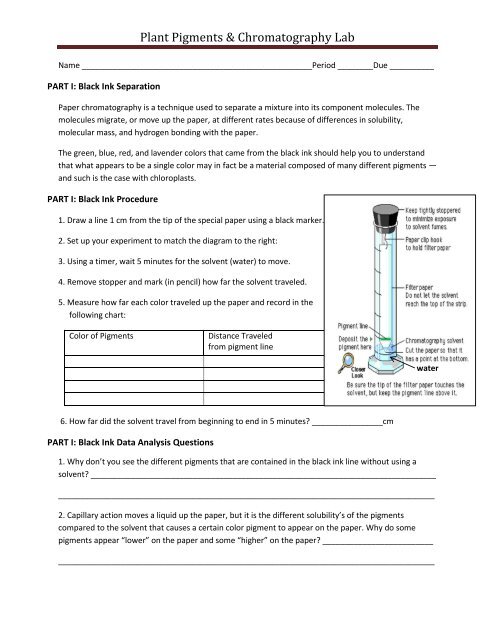

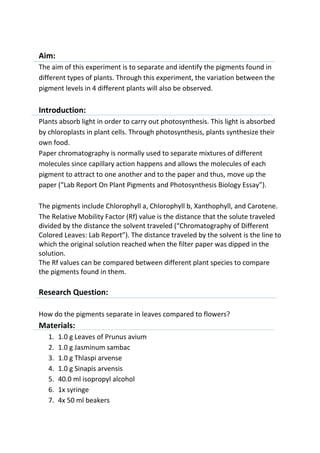

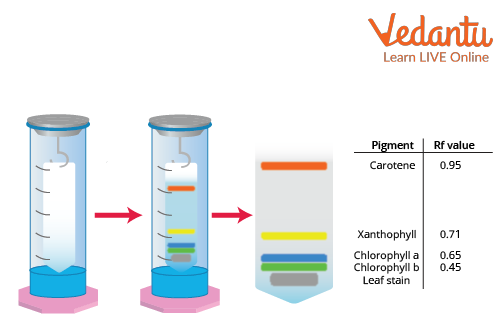

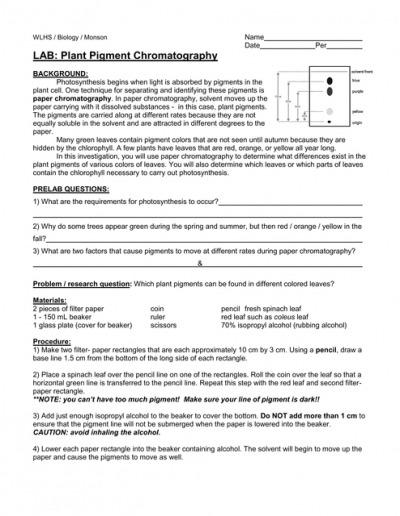


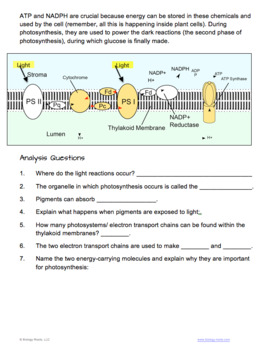
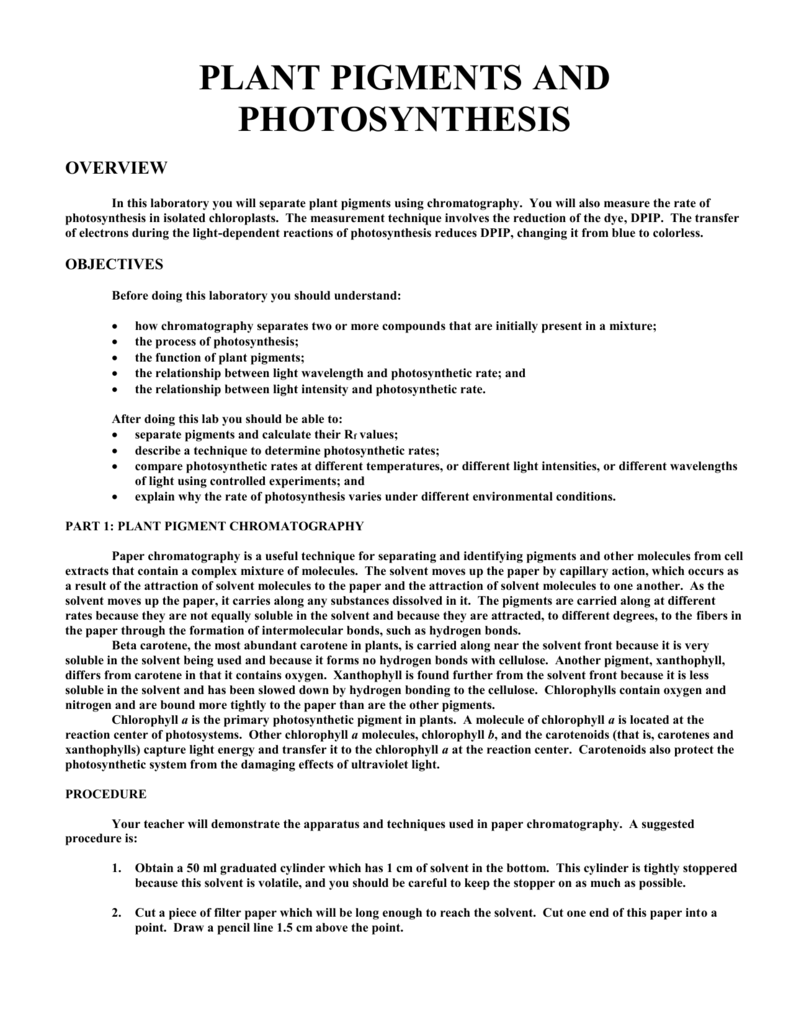






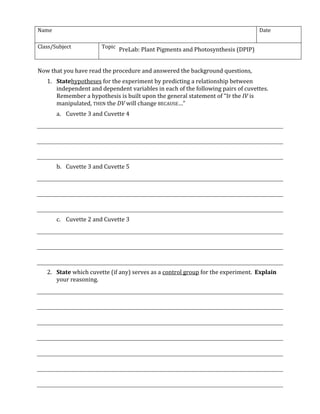




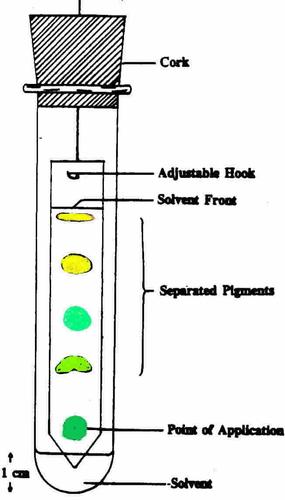
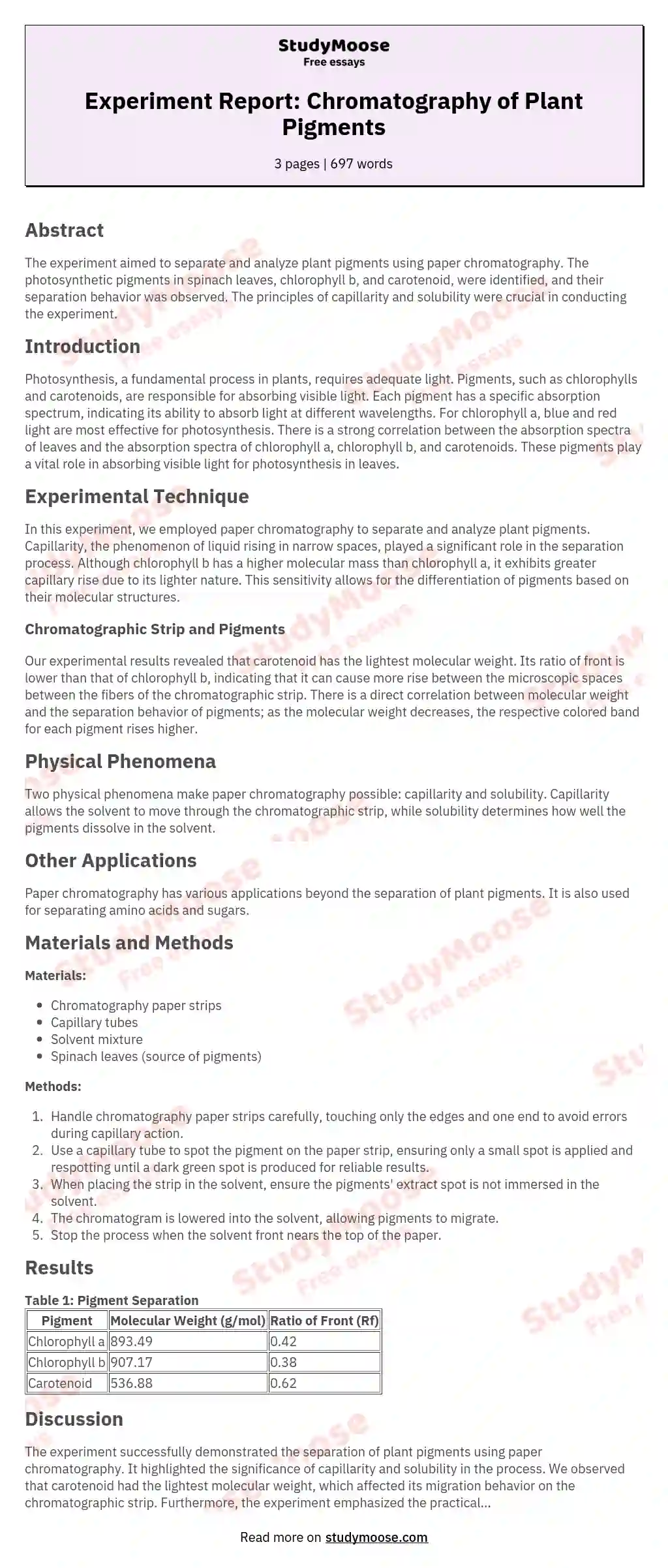


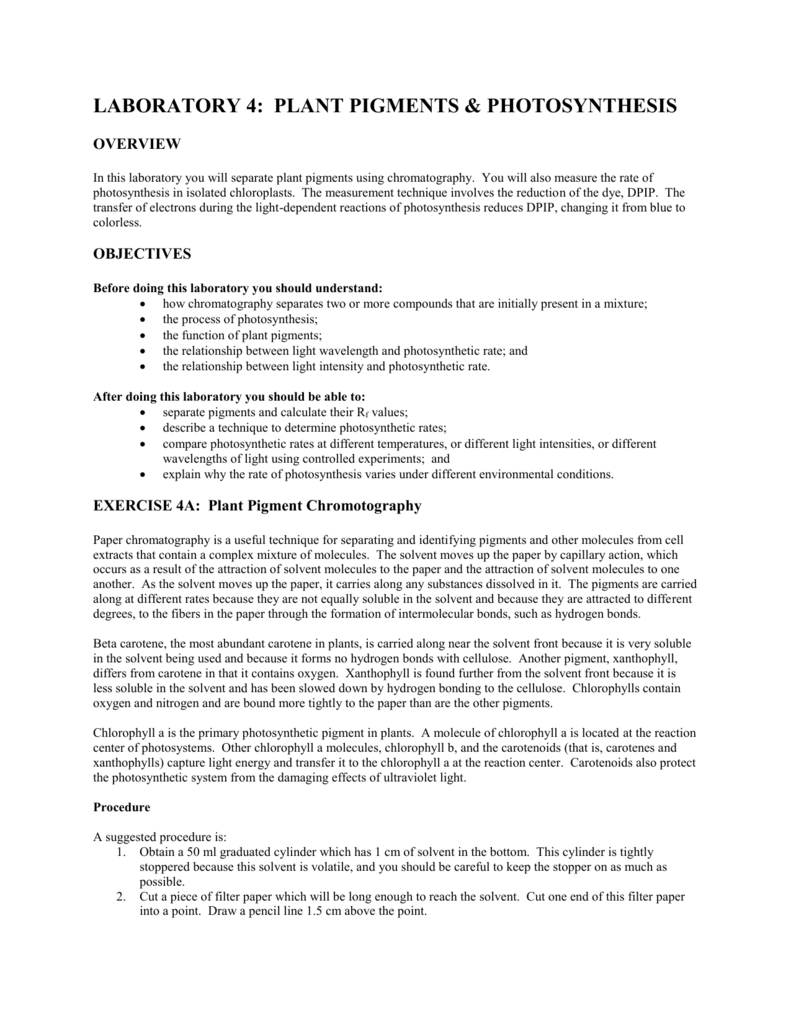
0 Response to "38 plant pigments and photosynthesis lab answers"
Post a Comment